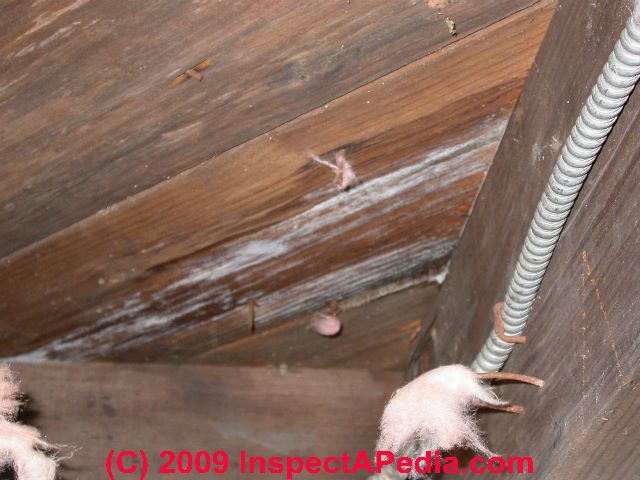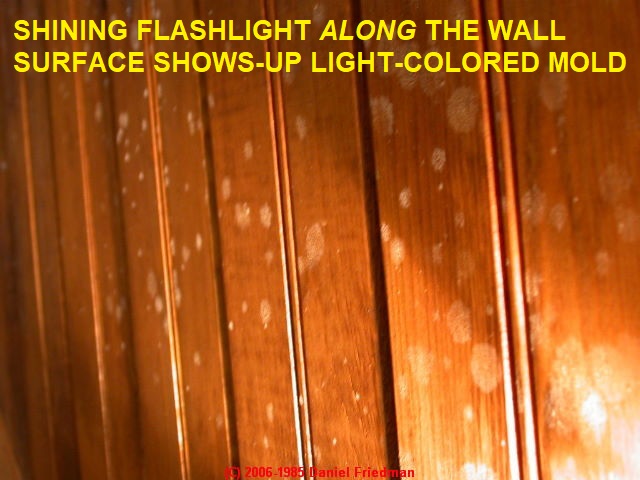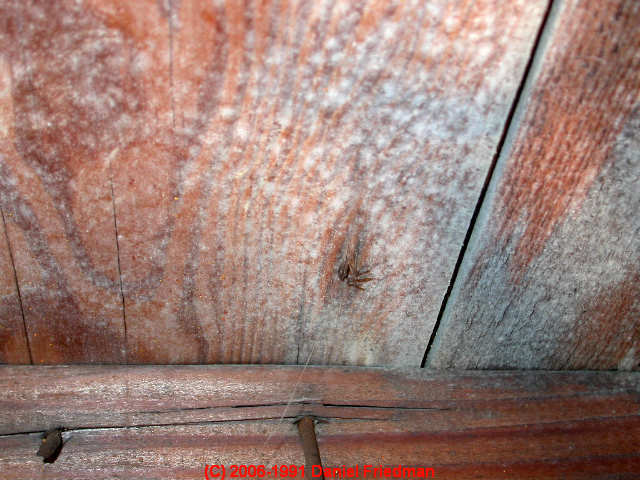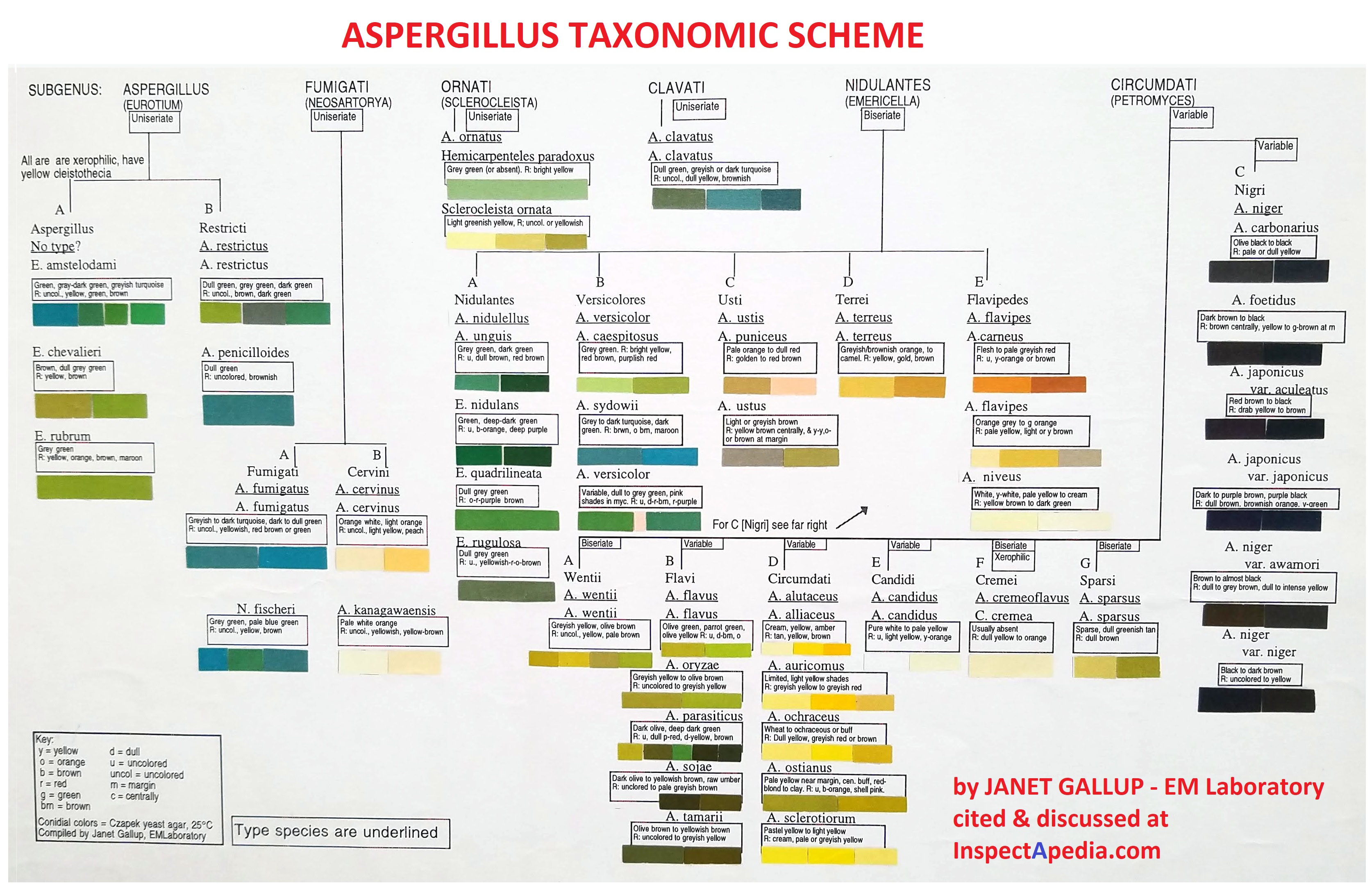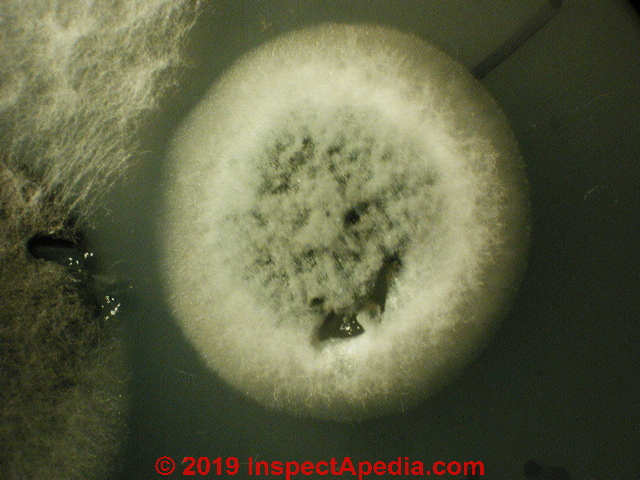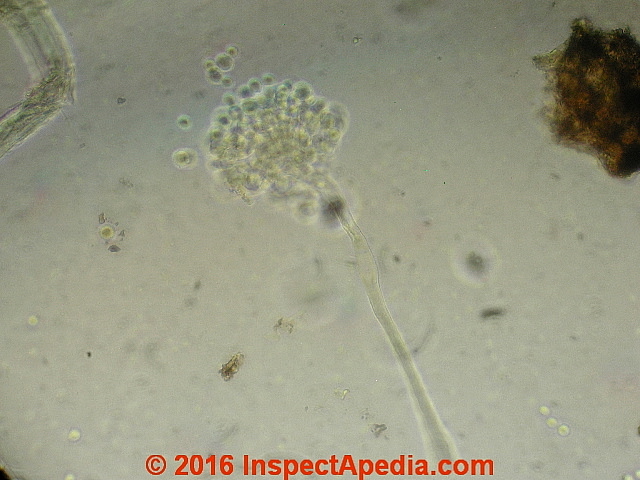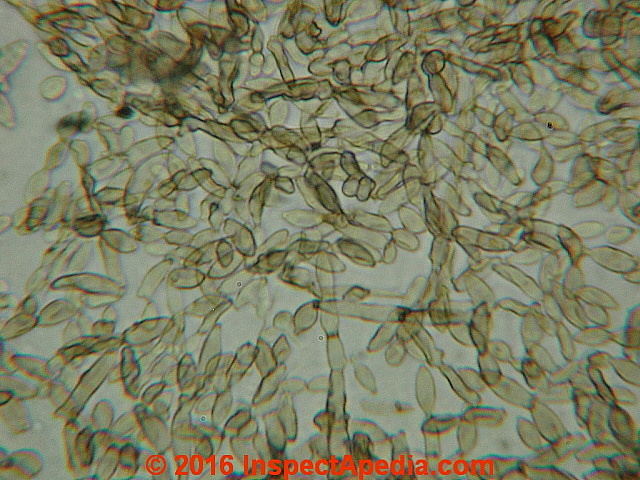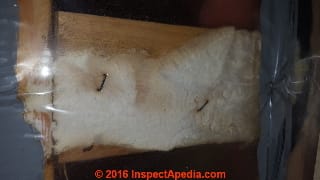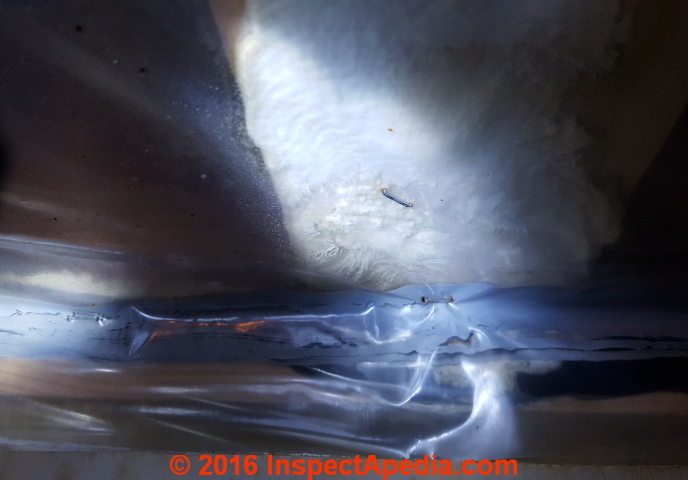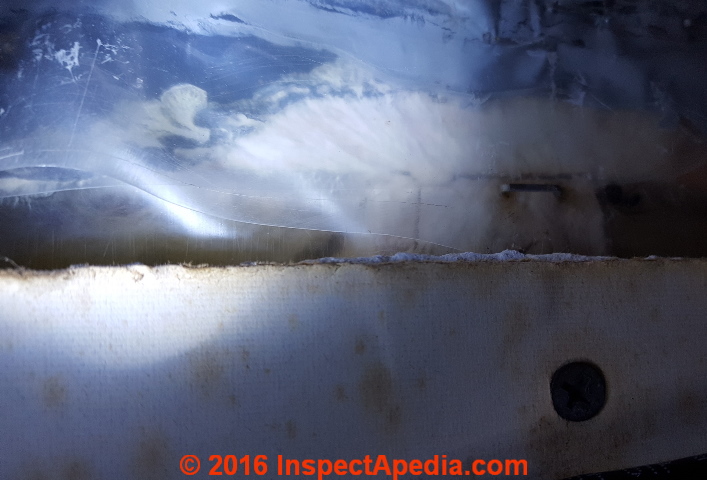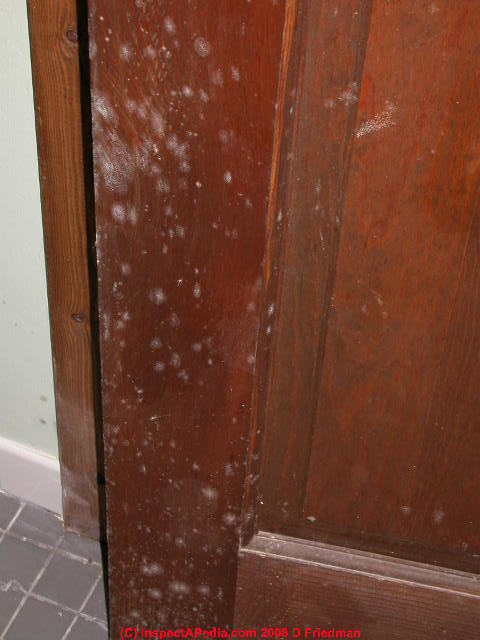 White Mold in the Home
White Mold in the Home
Detection and identification of white mold contamination in buildings
What does white & light-colored mold look like
?
- POST a QUESTION or COMMENT about white or light colored mold growth in buildings
White building mold identification photographs: how to recognize white fungal mold growth.
What does white mold look like on building surfaces and how hard is this mold to see? Photos of white, gray, & light-colored mold in buildings - how to find & recognize mold on building surfaces.
These photos of mold on indoor building surfaces may help you recognize mold in buildings, recognize probably-cosmetic mold, and recognize stuff that is not mold and does not need to be tested.
Photographs of light colored mold & other molds of various colors and textures in buildings. Special methods needed to spot white & light colored mold growth indoors
InspectAPedia tolerates no conflicts of interest. We have no relationship with advertisers, products, or services discussed at this website.
- Daniel Friedman, Publisher/Editor/Author - See WHO ARE WE?
Photographs Help Identify Mold in Buildings
 What white or light colored mold looks like in a home or in or on other buildings & building surfaces.
What white or light colored mold looks like in a home or in or on other buildings & building surfaces.
These mold samples and mold spores and their photographs and examples of materials sometimes mistaken for mold have been collected in the U.S., Spain, Mexico, France, as well as in other countries where I've studied bioaerosols.
[Click to enlarge any image]
For photos and an explanation of white fluffy stuff or white crystalline material often found on building walls, especially on masonry surfaces, but that is not mold,
see EFFLORESCENCE SALTS & WHITE DEPOSITS
Also see the white or light colored mold discussed
A great many white and light-colored grayish molds can be easily seen on building surfaces, especially on the exposed or inner wall-cavity side of drywall in buildings that have been exposed to wet or flooding.
Some of these white or very light gray molds include members of the Aspergillus or Penicillium genera as well as some basidiomycetes.
Our white building mold photo of mold growth along the bottom edge of the drywall shown just above illustrates that other "white molds" in found in buildings may not be the fruiting bodies (spore producing structures) of mold but instead may be the mycelia (think "root hairs") of many different genera/species of fungi that at their fruiting bodies will be seen in other colors and textures.
Fungal mycelia produced by many if not most mold colonies are themselves white to light gray in color.
Mycelia: a mass of hyphae; the thallus of a fungus, this is the vegetative body portion of the organism, akin to the "root" structure of a plant, used to absorb nutrients. Mycelia would not easily be visually identifiable as belonging to a specific species unless other components of the fungus are present.
Particles of this material are probably allergenic. - details are
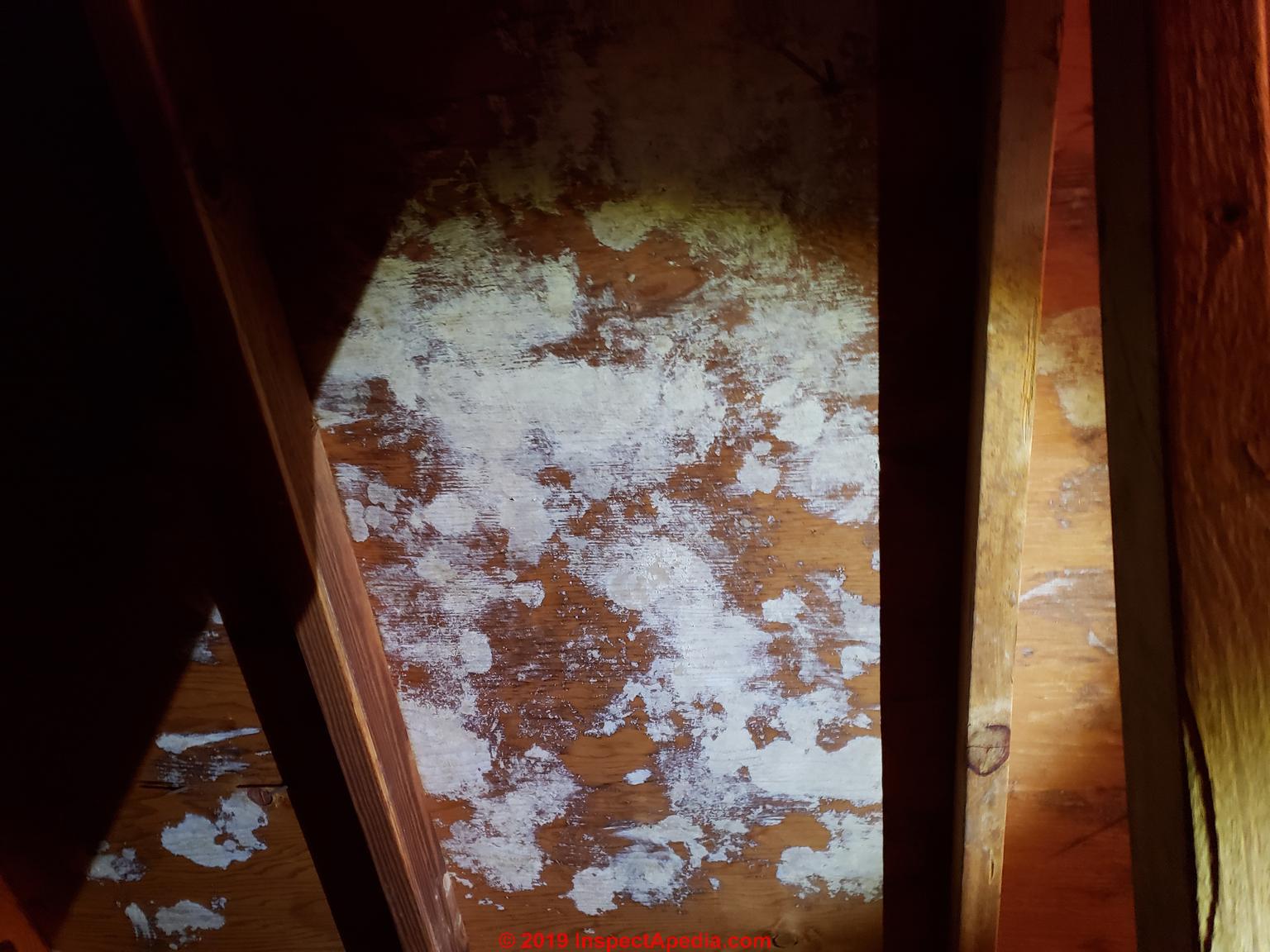 Mycelial cord, a discrete filamentous aggregation of hyphae which, in contrast to a rhizomorph, has no apical meristem; syrrota; - op cit.
Mycelial cord, a discrete filamentous aggregation of hyphae which, in contrast to a rhizomorph, has no apical meristem; syrrota; - op cit.
This photo of white mold shown on the under-side of this plywood roof sheathing was posted by an InspectApedia.com reader
at MOLD APPEARANCE on VARIOUS SURFACES and is discussed in our article.
It's possible that a closer examination of the white "stuff" on this plywood will find that we are looking at thick mycelial growths of a fungus.
At ATTIC MOLD, WHAT IT LOOKS LIKE we address a remediator's assertion that they could identify the white mold genera in this photograph as Aspergillus by sight alone.
Most white building molds can not be reliably identified to genera/species without microscopic analysis by a qualified aerobiologist/microscopist in a test lab.
Article Contents
- WHITE MOLD & FUNGUS PHOTOS Identification photographs of white mold & rot on indoor surfaces
- WHITE & OTHER MOLDS in DUCTWORK
- WHITE FUNGUS GROWTH in INSULATED WALL
- WHITE FUNGAL GROWTH on WOOD DECK JOIST - flat white, peels off
Identification Photographs of White & Light-Colored Mold Growth in Buildings
Here are photographs of both obvious white mold & fungal growth in buildings and also more difficult to see white or light gray mold growth on building surfaces.
Above we show white mold growth on tongue and groove subflooring in an older home in the northeastern U.S.
Below we see extensive white fungal growth (white mold growth) on OSB subflooring and on a floor joist over a wet crawl space in New York.
When you see a white "fungus" or "mushroom" like structure you're seeing the fruiting body of some mold species.
Other white or light colored moulds in buildings appear as tiny white spots, even as white or gray or light-green "dust" as you'll see in our photographs in this article.
Light colored molds, depending on the genera species, may be more of a health risk than the infamous "toxic black mold" that people look for in buildings.
Fungal groups such as Penicillium sp. and Aspergillus sp. produce species in a wide range of colors, some of which can be quite light in color and difficult to spot on building surfaces, but these molds may produce small, easily-airborne toxic or pathogenic mold spores that present a health risk to building occupants.
White stuff that is not mold
Beware: many people mistake mineral salts or efflorescence for white mold. Efflorescence is a white crystalline salt left on masonry surfaces where water or moisture have been evaporating.
See STUFF THAT IS NOT MOLD for photos of white fluffy material or white crystalline material that is often mistaken for mold.
Above we show white mold on wood subflooring and on OSB subflooring in a wet crawl space. Below we show additional photos of white and light colored molds found in buildings.
The white mold growing on this basement door was hard to spot without careful use of lighting. It looks almost like white dust, but unlike settled dust, a closer look at the mold-suspect surface will show growth patterns of the fungus and a relationship between the mold location and moisture or water exposure.
Dust tends to be more uniform over a specific building surface whereas mold on building surfaces tends to grow in colonies such as shown in our white mold on paneling photo below.
The white mold growing on this basement stairwell paneling was impossible to see until we directed our flashlight across the surface.
Read LIGHT, FLASHLIGHT for MOLD - proper use of a flashlight can help spot mold on paneling and other building surfaces.
Also see how LIGHT AIM FINDS MOLD & OTHER PARTICLES.
Here is a photograph of white mold that was very easy to see (and possibly some light-green mold) on yellow pine tongue and groove roof sheathing visible in the attic of an older home in the Northeastern United States.
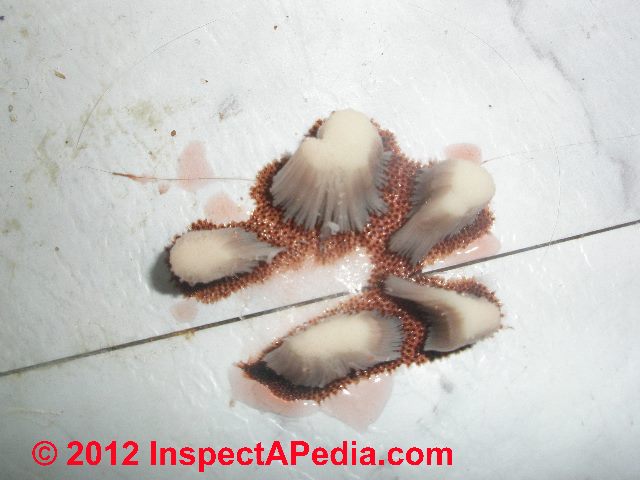
White mold that turns brown - Eg: Stemonitis sp.
Here is a photograph of a white fungus found growing on resilient flooring in an Australian bathroom. This fungus was very easy to see but was for a time a bit curious.
Covered and kept moist for just a brief interval, this Stemonitis sp. matured into an easily recognizable form of brown slime mold that we illustrate and discuss
at MOLD SAFETY ADVICE for TENANTS
and also in more detail
White mold that turns green, red, yellow, brown, tan, orange - eg. Aspergillus sp.
[Click to enlarge any image]
Aspergillus occurs as about 180 different sub-species (some sources list 250 species) of which about 20 are commonly found on building surfaces. ( US CDC www.cdc.gov/fungal/diseases/aspergillosis/causes.html )
The Aspergillus Taxonomic Scheme generously provided above by Janet Gallup, EMLaboratory, shows that while there are light colors of species of Aspergillus, most of its species are more-exciting in their pigment.
The color of common Aspergillus mold colonies in buildings ranges from black or very dark brown (A. niger) through greens, yellows, tans.
A brand new Aspergillus colony may appear as a white growth but usually when we see species of Aspergillus on a building surface it's not brand new (hours to days old) and it's got color. Photo above: a mold colony growing in culture, photographed by the author [DF] at McCrone Research Institute in 2003.
As the Aspergillus colony matures it darkens to green, green-gray, or green-brown with a white apron at the margin, very much depending on the species of Aspergillus and possibly as well as on what the Aspergillus has to eat - what material it's growing upon.
White Mold Growth on the Interior Surface of Fiberglass-lined HVAC Ducts
Above: white "growth" found on the interior surface of fiberglass-lined HVAC ducts in a home in Atlanta, GA in 2016. Look closely to see the presence of clear adhesive tape being used to collect a sample from this surface to permit laboratory analysis.
Samples from this fiberglass duct were examined in our InspectApedia.com forensic laboratory.
Above and below: an example of lab test results included these.
Above first photo, sample 2, Aspergillus sp. conidiophore (photo center) and hyphae at upper left corner of the image.
Below, second photo sample 2, Cladorporium sp. in dense fungal growth on the surface.
Details of this air duct mold contamination study based on clear adhesive tape samples of the mold-suspect surface of the air duct are found
at FIBERGLASS AIR DUCT MOLD TEST.
Below: another example of white mold found in HVAC air ducts, on the duct fiberglass insulation. The photo below was posted originally
at MOLD APPEARANCE on VARIOUS SURFACES
Also see AIRBORNE PARTICLE & MOLD LEVELS in DUCTWORK.
White Mushroom-like Fungus Growing In Insulated Crawl Space Wall Cavity
Question: is this white stuff efflorescence or mold?
Hi, while cleaning out the 4 foot crawlspace of my split level house I noticed a black patch a foot long on the drywall.
Decided to remove it and look behind. Found a white crystal-like substance on all the 2x4s.
In one spot it looks like it is growing away from the 2x4 onto the vapor barrier in a oyster shell shape.
This is an outside wall, insulated with fiberglass and covered in drywall. It also is where the water pipe is located for the outside use.
The lower right corner shown below has a lot of dark patches on the wood. We've owned 10 years and never had any water leak. Any way I can attach or send a photo? Thank you.
Here [are more photographs] of the white stuff on the 2x4s in my insulated crawlspace.
This is a horizontal 2x4 at head height (ceiling of crawlspace which is under floor for the living room on top). It has rather thick white growth as well as branches reaching out making contact with the vapor barrier.
I can see that all 2x4s within a 4ft area have this. Suspect condensation from copper pipe leading through here to exterior has created sustained dampness. House built in 1995.
Thanks for identifying the white stuff, if at all possible. I want to see if it's safe for me to remove all remaining drywall, vapor barrier and insulation in order to find the issue, and clean the area. I'm hesitant to let the white stuff "breathe" out in the air without knowing for sure what it is.
The only local mold expert said in 40 yrs never seen white stuff I am describing, so he said no use he comes out. - Anonymous by private email 2016/11/09
This question appeared originally
at MOLD APPEARANCE - STUFF THAT IS NOT MOLD
Reply: what to do about mushrooms growing in a building wall
Those photos look like white mushrooms growing in your wall, on wood surfaces. That's not efflorescence
Typically basidiomycetes or wood-rotting fungi grown on wet wood and can appear rather quickly even indoors in wet conditions, so I cannot guess from the white fungus how long this problem has been going on.
These fungal fruiting bodies may appear in any of many colours, commonly brown, white, red, even blue or very dark, almost black. More examples of mushrooms growing in or on buildings are
at BROWN MOLD PHOTOS
and
at MOLD on DIRT FLOORS - separate article, includes white mold on dirt in crawl spaces & basements
When you can I'd like to see also a couple of more-distant shots of the wall to see the situation as well as to see photos of the same sides of the building from outdoors.
You should
- Investigate further: Expect there to be other mold present, both visually obvious and not.
The wet conditions that caused this fungal growth are likely to also have invited other mold genera species that do not produce large white basidiomycete fruiting bodies which is what your photos seem to display.
I'd like to see photos of the material when the plastic is removed.] You should also inspect and probe the wood structure for rot.
More help is
at HIDDEN MOLD, HOW TO FIND - Remove the mold and fungal growth: Plan to remove all visibly moldy material such as insulation.
You can reduce personal risks by wearing protective clothing, a HEPA respirator, goggles, etc., and you can reduce the chances of blowing moldy dust into the upper, occupied part of your building by creating negative air pressure in the crawl space - a professional would seal off the area and install one or more air handlers or fans blowing "out" of the crawl space.
More help is
at MOLD ACTION GUIDE - WHAT TO DO ABOUT MOLD.
I do not think you need to "test" for mold when a fungus is plainly visible. - Remove other moldy materials that cannot be cleaned: Remove any nearby insulation and any insulation that was wet, to a stud bay or 18" space of clear un-contaminated, dry, clean insulation or material.
Watch out: be alert for discovery of a large area of mold contamination. If you find more than 30 square feet of visibly contiguous mold growth then it's probably time to hire a professional.
See MOLD / ENVIRONMENTAL EXPERT, HIRE ? - Clean and dry the area: Clean the exposed cavity and let it dry before re-insulating and restoring the wall.
- Re-Insulate & repair damage: in my opinion, using fiberglass insulation below ground in an area likely to be wet or exposed to high humidity invites mold problems in the future. I'd consider a closed-cell foam insulation as an alternative.
- Fix the cause of mold growth: Find and fix the source of water entry so that it doesn't recur. I suspect that there has been water entry into your wall or crawl space.
See CRAWL SPACE DRYOUT
...
...
Continue reading at MOLD APPEARANCE - WHAT MOLD LOOKS LIKE or select a topic from the closely-related articles below, or see the complete ARTICLE INDEX.
Or see WHITE MOLD PHOTO FAQs - questions & answers posted originally on this page
Or see these
Recommended Articles
- CAR MOLD CONTAMINATION - examples of light and white molds on car interior
- EFFLORESCENCE SALTS & WHITE DEPOSITS - for examples of moisture-related white deposits that are not mold.
- HIDDEN MOLD in OTHER PLACES for details of this and other places to look for hidden mold in buildings.
- HUMIDITY CONTROL & TARGETS INDOORS for an example of white mould occurring in a U.K. home with venting & humidity questions.
- LIGHT AIM FINDS MOLD & OTHER PARTICLES - how to use your flashlight successfully
- LIGHT COLORED MOLD - more light coloured moulds besides white can be hard to spot
- LIGHT, FLASHLIGHT for MOLD - proper lighting shows up hard-to-spot mold
- MERULIPORIA HOUSE EATING FUNGUS
- MILDEW ERRORS, IT's MOLD
- MOLD APPEARANCE - WHAT MOLD LOOKS LIKE - a Photo ID Library for detection and identification of mold allergens on indoor building surfaces.
- MOLD APPEARANCE - STUFF THAT IS NOT MOLD
- MOLD GROWTH on SURFACES, PHOTOS
- ROT TYPES, BROWN SOFT WHITE
- WHITE MOLD PHOTOS
- WHY DOES MOLD GROW in INSULATION? that includes photos and test results examining suspected mold on the surface of fiberglass-lined HVAC ductwork.
Suggested citation for this web page
WHITE MOLD PHOTOS at InspectApedia.com - online encyclopedia of building & environmental inspection, testing, diagnosis, repair, & problem prevention advice.
Or see this
INDEX to RELATED ARTICLES: ARTICLE INDEX to MOLD CONTAMINATION & REMEDIATION
Or use the SEARCH BOX found below to Ask a Question or Search InspectApedia
Ask a Question or Search InspectApedia
Try the search box just below, or if you prefer, post a question or comment in the Comments box below and we will respond promptly.
Search the InspectApedia website
Note: appearance of your Comment below may be delayed: if your comment contains an image, photograph, web link, or text that looks to the software as if it might be a web link, your posting will appear after it has been approved by a moderator. Apologies for the delay.
Only one image can be added per comment but you can post as many comments, and therefore images, as you like.
You will not receive a notification when a response to your question has been posted.
Please bookmark this page to make it easy for you to check back for our response.
IF above you see "Comment Form is loading comments..." then COMMENT BOX - countable.ca / bawkbox.com IS NOT WORKING.
In any case you are welcome to send an email directly to us at InspectApedia.com at editor@inspectApedia.com
We'll reply to you directly. Please help us help you by noting, in your email, the URL of the InspectApedia page where you wanted to comment.
Citations & References
In addition to any citations in the article above, a full list is available on request.
- Fungi, Identifying Filamentous, A Clinical Laboratory Handbook, Guy St-Germain, Richard Summerbell, Star Publishing, 1996, ISBN 0-89863-177-7 (English)
- In addition to citations & references found in this article, see the research citations given at the end of the related articles found at our suggested
CONTINUE READING or RECOMMENDED ARTICLES.
- Carson, Dunlop & Associates Ltd., 120 Carlton Street Suite 407, Toronto ON M5A 4K2. Tel: (416) 964-9415 1-800-268-7070 Email: info@carsondunlop.com. Alan Carson is a past president of ASHI, the American Society of Home Inspectors.
Thanks to Alan Carson and Bob Dunlop, for permission for InspectAPedia to use text excerpts from The HOME REFERENCE BOOK - the Encyclopedia of Homes and to use illustrations from The ILLUSTRATED HOME .
Carson Dunlop Associates provides extensive home inspection education and report writing material. In gratitude we provide links to tsome Carson Dunlop Associates products and services.


